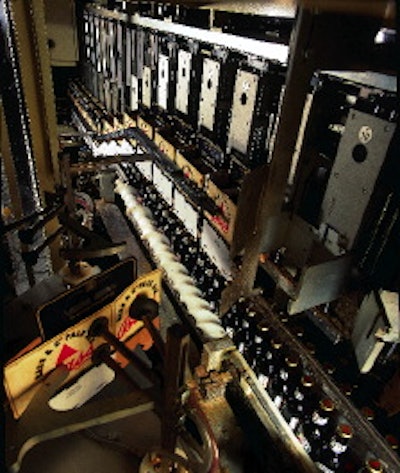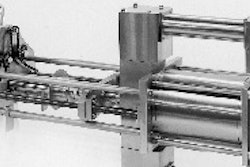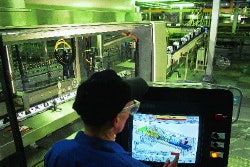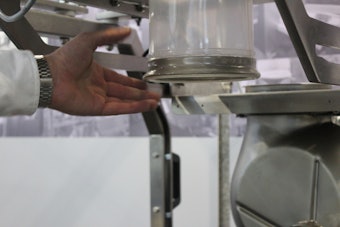Exports to the U.S. have been growing steadily, with sales up 20% alone in the last year, according to Jonathan Turner, marketing controller. Since consumers in the U.S. are used to basket carriers for bottled imports, Bass selected two of Riverwood's unique Autoflex(TM) 1000 basket packers for use on each of two bottling lines, which run at 750 bpm. The carriers themselves are 22-pt Aqua-Kote® wet-strength carrier board from Riverwood, printed offset in five colors plus an emulsion coating. Virtually all of the product packed on the Autoflex basket packers is destined for the U.S. Initially added in early '95, the Autoflex machines stand apart from traditional basket openers and drop packers. Those machines usually rely on pick-and-place or cam-operated mechanisms that grip the bottles by the necks and lower them into the waiting baskets, which have been previously erected by separate basket opening machines. The Autoflex cleverly reverses the loading principle. The bottles remain fixed and the baskets--with no bottoms--are lowered over the bottles. The bottoms are then folded underneath. When the baskets are first erected, the bottom flaps remain unfolded, extending down from the sides and exposing the cells of the six-pack from underneath. Thus, the narrow end of the bottle enters the cell first as the basket is lowered. Riverwood maintains that this more forgiving method contributes to smoother operation and reduced jams. Eifion Hughes, Bass Cape Hill's technical support manager, concurs: "This is a much neater operation than a drop packer. The bottles don't get handled anywhere near as much because the baskets are loaded over them and locked underneath. In comparison, drop packers are renowned for dropping bottles when they're not supposed to." Similar infeed In November '95, the Autoflex on Line 1 was replaced by an updated version that relies on timing screws (much like the infeed on the Marksman 2000) instead of lug chains to separate product into groups. The benefit: more efficient operation and less downtime. Hughes explains: "On the older machine you're looking at routine replacement of the chains, which get coated in paperboard dust. The chains can be difficult to lubricate and eventually they start to wear and break down." Hughes has noticed a difference compared to the older lug-driven Autoflex--"mostly in reduced downtime and improved reliability of the infeed," he says. In operation, bottles enter the continuous-motion in-line machine in two lanes. A starwheel controls back pressure and feeds containers to the two timing screws, one per lane. The screws separate the bottles into groupings of six. Meanwhile, a rotary carton picker system uses pneumatic vacuum pickup cups to pick baskets from the 7' long extended hopper, which holds over 1ꯠ cartons. After the basket is picked, a second set of vacuum cups "pre-open" the basket by momentarily grabbing the front panel as the basket moves away. Next, the basket is placed into one of a series of moving flights or pockets. As the baskets are placed in the pockets, which encircle the baskets on three sides, the baskets are forced open to conform to the pockets' shape. As the pockets traverse the length of the machine, they gently lower the baskets over the bottle groupings. At this point, the bottom flaps--consisting of a male panel with tabs and a female panel with slits--are compressed, folded and mechanically locked underneath using the same stationary guide mechanism on the Marksman 2000. No adhesives are used. No changeover required Because Bass just runs the machines for six-packs of bottled product for U.S. exports, it doesn't make any changeovers to this machine, apart from swapping paperboard carriers in the magazine. Product packed on these machines are 12-oz bottles of Bass Pale Ale, 330-mL bottles of Tennents 1885, and Hooper's Hooch, an alcoholic lemon drink in 330-mL bottles. Though each bottle differs slightly in shape, the machine requires no changes to accommodate them. "It's flexible enough to handle the two- to three-millimeter difference in the bottle diameters," says Hughes. It's also flexible enough to handle what Hughes estimates is a 1/4" variance in bottle heights. c



























